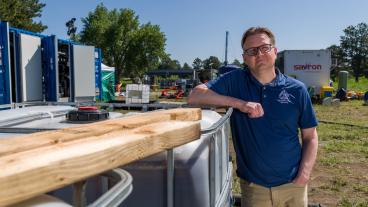Orange, tree-like cone structures up to two centimeters tall found in a California hot spring were built by a rich and diverse community of microbes, newly published research shows.
These microbes, living in a California hot spring aptly named “Cone Pool” by researchers in the Long Valley Caldera, just east of Mammoth Mountain in California, built sturdy Christmas tree-like structures using calcium carbonate—the same mineral used by corals to form their skeletons.
John Spear, professor of civil and environmental engineering at Colorado School of Mines, was part of the international team of researchers working on the project. Their findings were published Nov. 21 in the journal npj Biofilms and Microbiomes.
“It is fascinating to observe these intricate structures under the microscope, and see that they bear strikingly similarity to those preserved in ancient rocks, built millions of years ago by ancient ancestors to the microbes in Cone Pool,” said James Bradley, co-lead author and postdoctoral research fellow at the University of Southern California. “This means that we have found a new modern analogue for those ancient structures that might provide clues into the formation and preservation of ancient counterparts.”
The structures, resembling microbial filaments when viewed under an electron microscope, are made up of long threads, intertwined around tiny grains of calcium carbonate. The study suggests that they are the result of the activity of millions of different microbes, each with a metabolism that contributes to the cone-building process.
Characterization of the microbes’ DNA indicates that the community is highly diverse and capable of metabolisms including photosynthesis, which might encourage the formation of these never-before-seen structures.
“This type of insight would be impossible to achieve without the collaborative, multidisciplinary nature of the research,” said Bradley Stevenson, a microbiologist at the University of Oklahoma.
The international team of researchers included members from the University of Southern California; California State University, Fullerton; Colorado School of Mines; UES Inc. of Dayton, Ohio; University of Oklahoma; and Pontificia Universidad Católica de Chile. They were brought together by the International GeoBiology Course at USC in 2015.
The annual course brings together scientists from a range of disciplines and levels of experience with the overarching aim to explore the co-evolution of the Earth and life on Earth. All results presented in the paper were generated from fieldwork and experiments conducted as part of the course, and lead authors Bradley, Leslie Daile and Chris Trivedi were students in the 2015 course.
“The best kinds of research can be done at the intersection of different kinds of science—here geology, geochemistry and microbiology come together to better reveal what is known about life and Earth’s history,” said Spear, the corresponding author who co-directed the course.
The project was funded by the Agouron Institute, the Center for Dark Energy Biosphere Investigations (C-DEBI) and the Zink Sunnyside Family Fund.
CONTACT
Emilie Rusch, Public Information Specialist, Communications and Marketing | 303-273-3361 | erusch@mines.edu
Mark Ramirez, Managing Editor, Communications and Marketing | 303-273-3088 | ramirez@mines.edu



